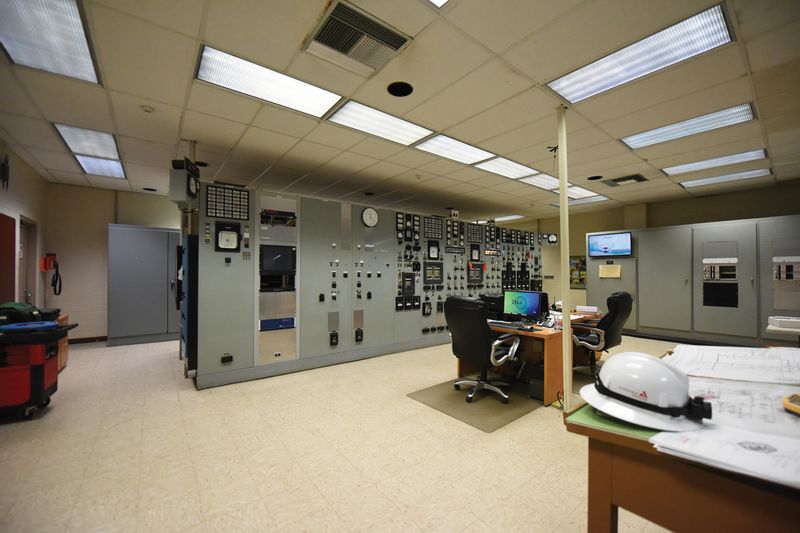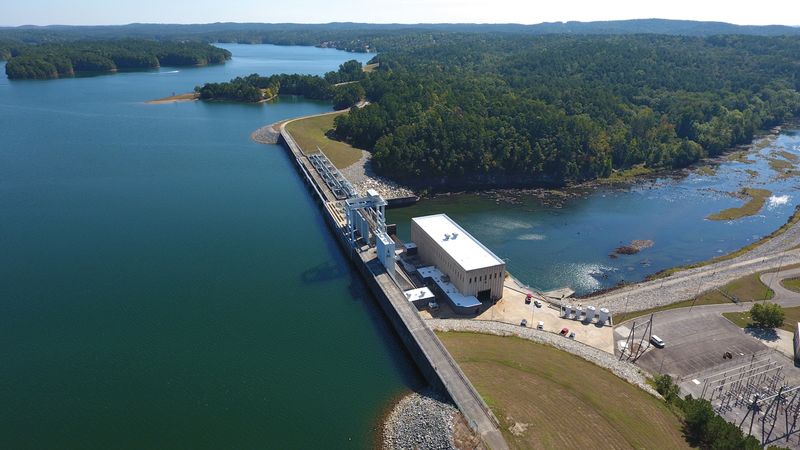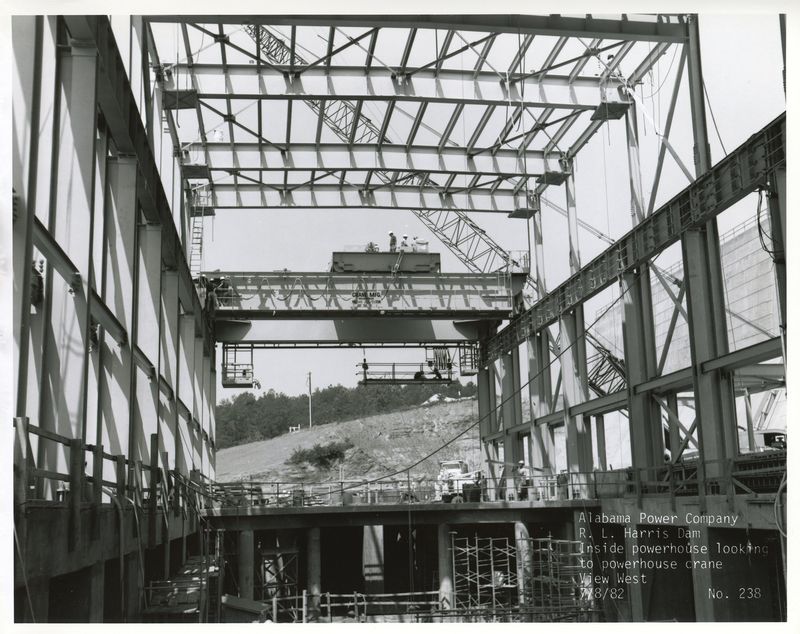Our Own Little Dam
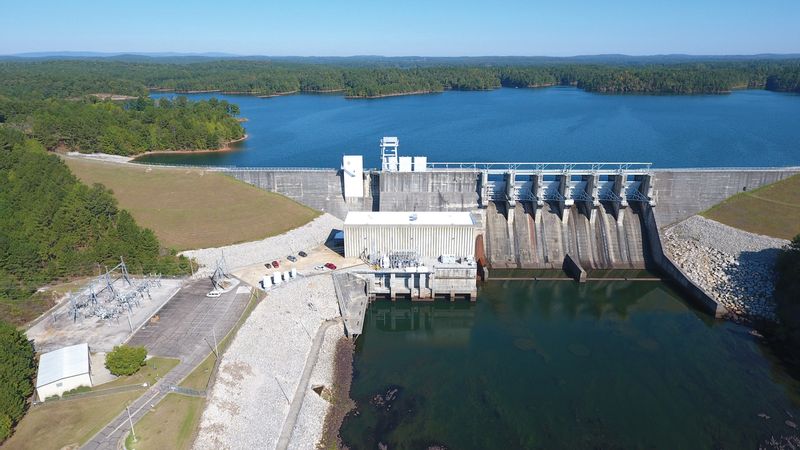
🏞️ By Tammy Lovvorn
📸 Photos courtesy of Alabama Power Company
Alabama Power Company constructed the first hydroelectric facility on the Coosa River in 1914 and the last hydro plant on the Tallapoosa River in 1983. There are 14 hydro plants which generate about 7% of Alabama Power’s total electricity.
We are fortunate that APC (Alabama Power Company) made the decision to build one here! We call it Lake Wedowee but just how did it come to be?
Understanding how Lake Wedowee came into existence requires a little background and history about the river basin. Lake Wedowee is part of the Alabama Coosa Tallapoosa River Basin (ACT). This river basin starts in Georgia and Tennessee and drains into Mobile Bay.
In the 1940’s, the 77th Congress laid out a plan to study the ACT for flood control, hydropower and navigation—all under the authorization and guidance of the River and Harbor Act.
In 1966, the Corps of Engineering was authorized to develop a site for flood control, hydropower and other purposes as part of the comprehensive plan for the development of Alabama-Coosa River System (now known as the ACT). The site was called Crooked Creek and was located 15 miles below the confluence of the Tallapoosa River and the Little Tallapoosa River.
🔌 From Plans to Power
Alabama Power Company (APC) filed an application with the Federal Power Commission to study the Crooked Creek site in 1966. Two years later, on November 5, 1968, APC filed an application for the proposed project and was issued a license for the construction, operation and maintenance of the Crooked Creek Hydroelectric Project No. 2628 on December 28, 1973.
At the request of APC, the project was renamed R. L. Harris Dam and Lake on February 15, 1974. The dam was named in honor of Rother L. “Judge” Harris, an Alabama Power director and vice president of electric operations. He was a dedicated employee for 45 years and retired in 1968.
Construction on the dam began in November of 1974 and started and stopped before being completed on October 27, 1982, and the lake began filling. The reservoir reached the 785 feet mark on December 16, 1982. The powerhouse and administrative buildings were completed in 1983 and the units became operational on April 20, 1983.
⚙️ How It Works
Lake Wedowee Dam is a gravity concrete structure measuring 1,142 ft in length and stands at a height of 150 ft. The top elevation is 810 ft above sea level. The dam is made of 413,000 cubic yards of concrete. There are two 67,500 kilowatt units inside. The water wheels are 17 feet 4 inches in diameter and weigh 198,000 pounds. Water discharges at 3,449,268 gallons per minute per turbine when generating. 😲💧
The 9,870-acre reservoir we call Lake Wedowee has 367 miles of shoreline and a length of 29 miles. The reservoir has a maximum depth of 121 ft.
As you cruise by the dam on a beautiful weekend, you would think it is a simple structure. However, it is a little more complicated as I learned on my tour of the plant.
🔄 Energy in Motion
The forebay or reservoir holds the “energy/water” for the units. The intake structure collects the water and directs it into the penstocks (fancy word for pipes). The penstocks are 27 feet in diameter and carry water to the turbines through wicket gates, which regulate how much water flows to the turbine. Note, the turbines are located at the base of the dam.
Water spins the turbines which turns the generator and makes electricity.
🧠 Your physics lesson: kinetic energy from the flowing water is converted to mechanical energy which is then transformed to electrical energy. This is clean energy.
The water flows through the turbine and into the tailrace or river.
🚨 Flood Control & Safety
For flood control and water management, there are six Tainter gates, each 40.5 feet wide and 40.0 feet high located on the 310 ft spillway. These gates are like a giant sliding wall.
When the units are not generating electricity for the electrical grid, the wicket gates are closed, and air replaces water inside the draft tube which allows the turbine to spin freely with no resistance. (The wicket gates are like a door that can open inside the turbine to control how much water is released). The turbines are always spinning. This is called motoring.
Motoring allows hydro units to start producing electricity in a matter of seconds by pulling water from the lake and allows them to be used for voltage control for system stability.
This is why there is a large sign that gives warnings to boaters and fishermen about hazardous waters! ⚠️ It is best to abide by all signs around dams both on the reservoir side and the river side!
🌦️ It’s a Balancing Act
There are many other components to understanding how a dam works. The best way to learn more is to tour the facility. Tours are by appointment only.
Alabama Power employees operate the plant in accordance with rules and regulations set by the Corps and the Federal Energy Regulatory Commission (FERC). There are established rules the plant operates under for different situations, such as winter pool, summer pool, and weather events.
For example, during the winter months, the lake is at its lowest level, 785 ft. If there is a significant weather event, the plant cannot further lower the lake level to accommodate the rainfall. APC works with internal and external teams evaluating different scenarios on how to prepare for such events. I learned it is a balancing act!
🛶 Our Lake, Our Legacy
The plant has to make sure they are following the flood control management plan to ensure the safety of those downstream while maintaining a safe operating level in the reservoir.
Lake levels change for different reasons for flood control. In the summer months, the lake is at full pool for recreational purposes. At all times, water is released to protect ecosystems and habitats downstream and allow for navigation in the Alabama River and Mobile Bay.
📱 Want to Track the Lake?
APC has an app that can be downloaded on your smartphone, android, or computer. The app is called Shorelines and has information for each of their dams. You can see when the plant is generating, find permits for building, follow recreation activities, and other features. The best feature is the lake level! 🌊
🔗 https://apcshorelines.com/lake/harris/
💡 If you want to learn more about the benefits of hydroelectricity, visit their website:
🔗 https://www.alabamapower.com/clean-energy/hydroelectric-power.html
♻️ Community & Clean Energy
Alabama Power is more than a company providing electricity. It is a company that cares about its community, especially ours with its Renew Our Rivers program, which has been in existence for 25 years! APC organizes communities to come together to clean up rivers. Lake Wedowee’s next clean-up is scheduled for October 21-23.
This summer if you ride by the dam (at a safe distance) on our beautiful lake, I hope this article makes you think a little differently. A lot goes into maintaining this wonderful lake and generating clean renewable energy for the electrical grid.
The lake is an incredible place for you to spend time with your family and friends and create long-lasting precious memories! 💙
Remember — abide by the signs and stay a safe distance from the dam!
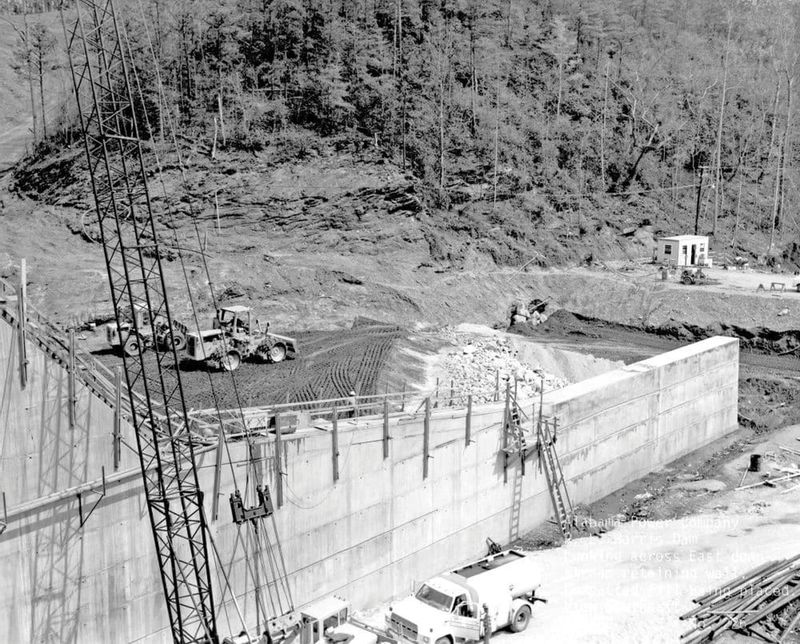
Click an image below to display the larger version.

Lake Wedowee Life magazine
104 W Broad Street
Wedowee, AL 36278
(256) 357-4557
www.LakeWedoweeLife.com

